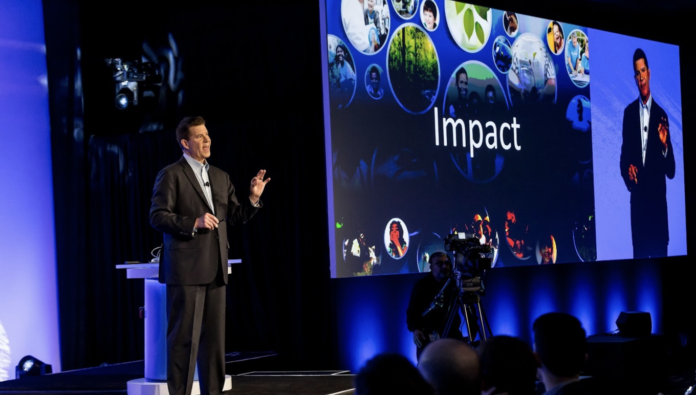
Former U.S. Under Secretary of State Keith Krach Receives Nation’s Highest Manufacturing Honor for $4.5 Trillion in Global Productivity Impact
Our analysis shows Krach’s transformational leadership in robotics, engineering automation, B2B e-commerce, digital business productivity, semiconductor manufacturing, and restoring America’s industrial edge led to a cumulative global productivity impact of more than $4.5 trillion.
Recognition at the Highest Level
Jointly presented by the American Society of Mechanical Engineers (ASME) and the Society of Manufacturing Engineers (SME), the 2025 M. Eugene Merchant Manufacturing Medal of ASME/SME is the manufacturing sector’s highest honor, recognizing exceptional innovation and leadership that advances the science and practice of manufacturing.
Krach was selected “for exceptional technological contributions and innovations that have transformed the manufacturing sector.” He will formally receive the award at the SME Fall Gala on October 5, 2025, in Anaheim, California.
“Krach’s career exemplifies how visionary leadership, entrepreneurial courage, and engineering excellence can deliver profound, lasting impact. His work continues to shape how the world designs, manufactures, trades, and transacts.” said Thomas Costabile, Executive Director and CEO of ASME. “This award recognizes Keith Krach’s lifelong record of transformational leadership across technology, manufacturing, economic policy, and diplomacy—driving global productivity, GDP growth, and quality of life.”
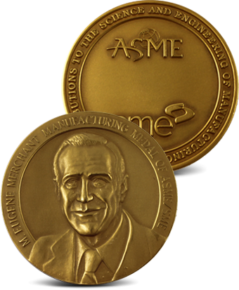
Krach joins a distinguished list of recipients that includes:
Donald E. Petersen, former CEO, Ford Motor Company; Norman Augustine, former CEO, Lockheed Martin; Koichi Nishimura, and former CEO, Applied Materials
See Purdue University’s announcement of the award here.
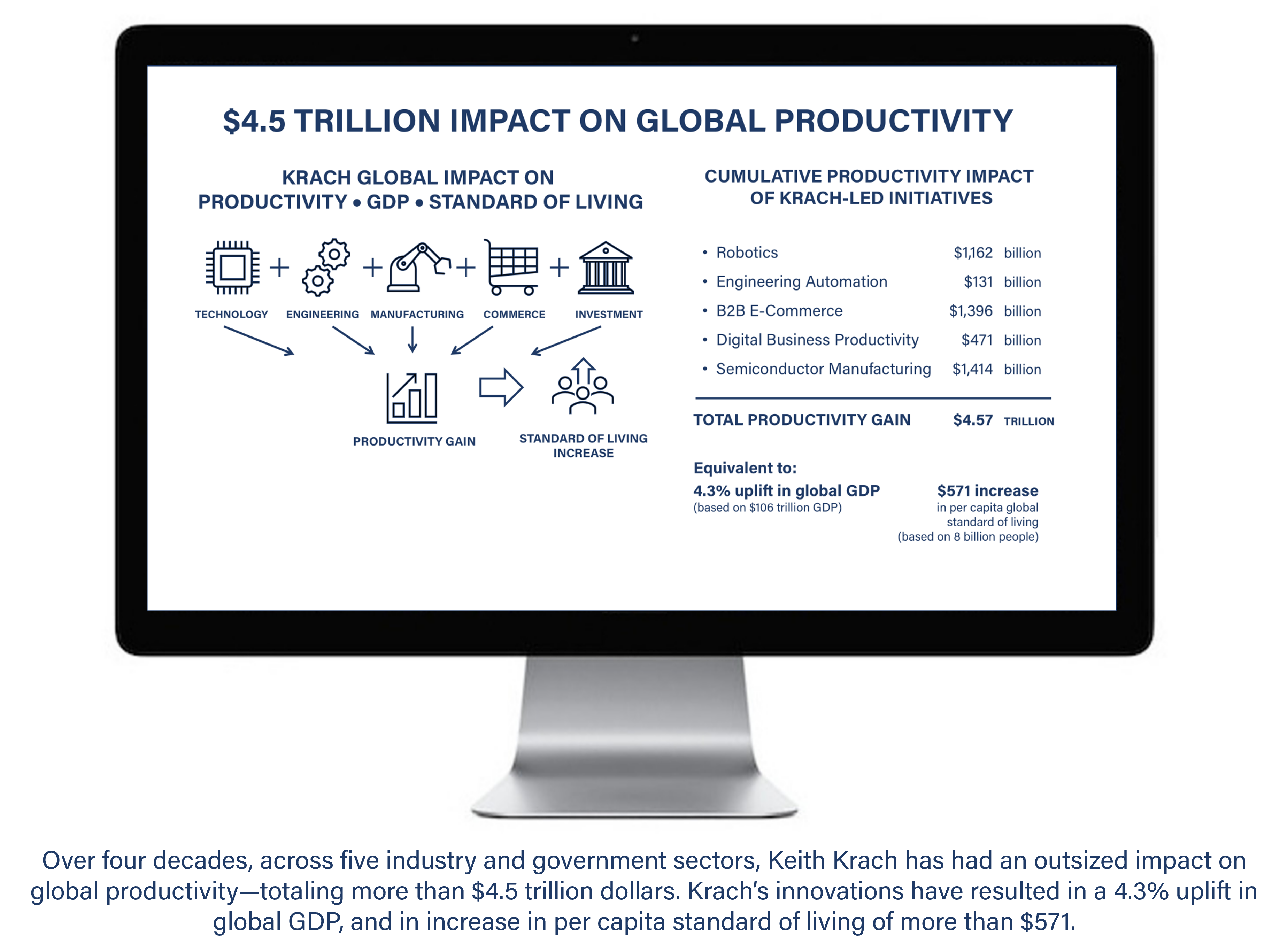
Note: Our analysts’ methodology and sources for productivity estimates related to Keith Krach’s career can be found here.
From Welder’s Torch to Global Stage
From his start as a twelve-year-old welder in his father’s Ohio machine shop to the architect of multi-trillion-dollar transformations in robotics, engineering automation, B2B eCommerce, digital business productivity, and semiconductor manufacturing, Keith Krach has quietly reshaped the engine of global productivity.
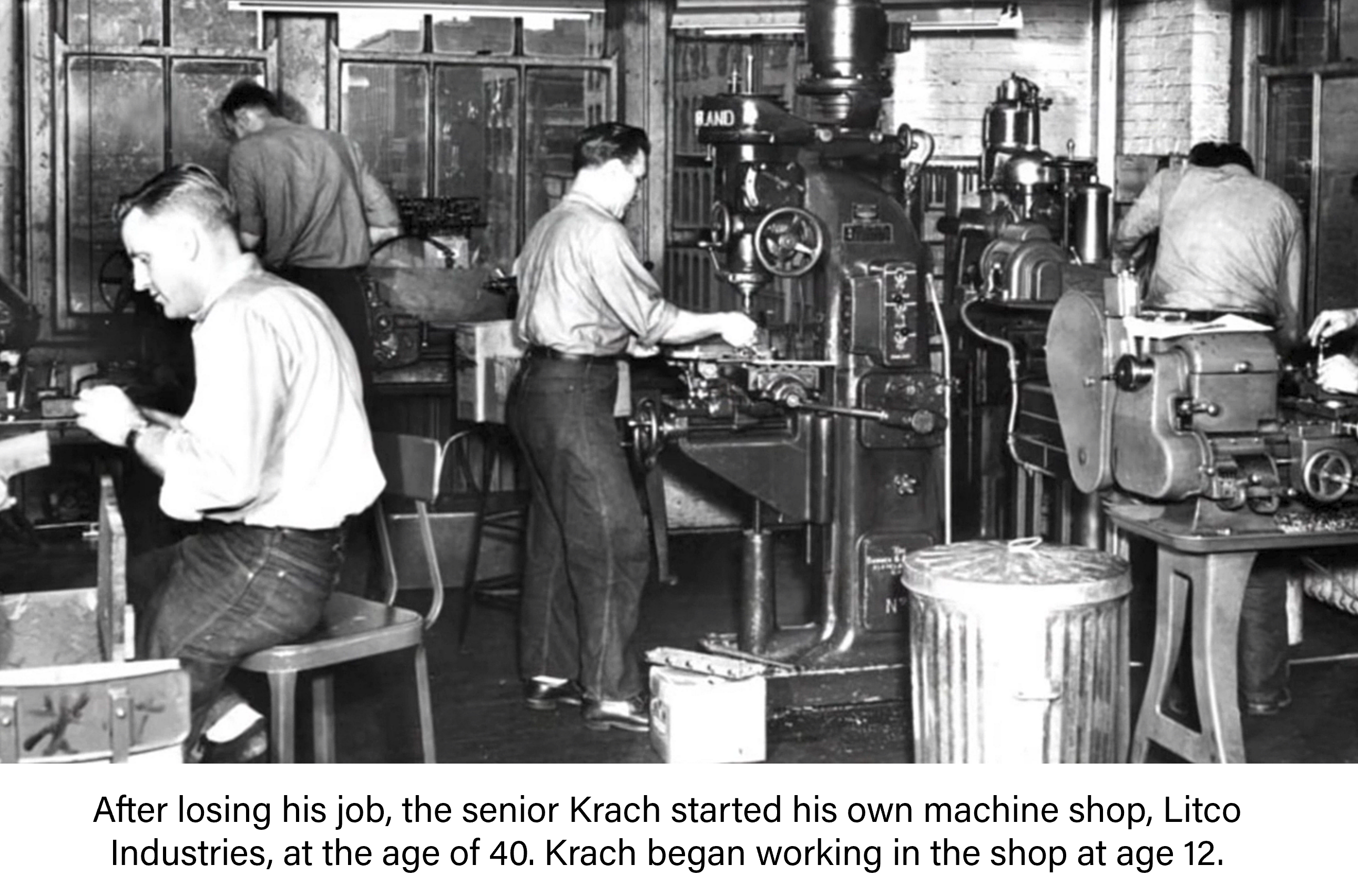
The son of a WWII veteran and small business owner, Krach was raised on grit, steel, and the value of earned progress. By age 15, he was programming CNC machines and handling deliveries, learning firsthand what productivity meant—not just for a company’s bottom line, but for a family’s survival.
That early work ethic earned him a General Motors scholarship to Purdue, where he studied industrial engineering and mastered systems efficiency. GM then sent him to Harvard Business School. But instead of returning to a predictable corporate path, Krach bet on reinvention—from launching GM’s pioneering industrial robotics venture to founding Rasna, Ariba, DocuSign, and ultimately serving as the U.S. Under Secretary of State.
This is the story of how one man’s integrity-driven leadership helped accelerate the modern global economy.
Igniting the Age of Robotics
By his mid-20s, Krach was already rocketing up the ranks at General Motors. At just 26, he became the youngest vice president in GM history and was tapped to lead the company’s first international joint venture—GMF Robotics, an unprecedented alliance with Japanese automation powerhouse FANUC. At a time when robots seemed more like science fiction than strategy, Krach saw them as the future of global productivity. Krach’s leadership didn’t just modernize assembly lines. It helped ignite a global transformation. By rethinking manufacturing from the ground up, GMF introduced predictive maintenance, end-to-end automation, and digitally integrated workflows. It wasn’t just about machines—it was about momentum.
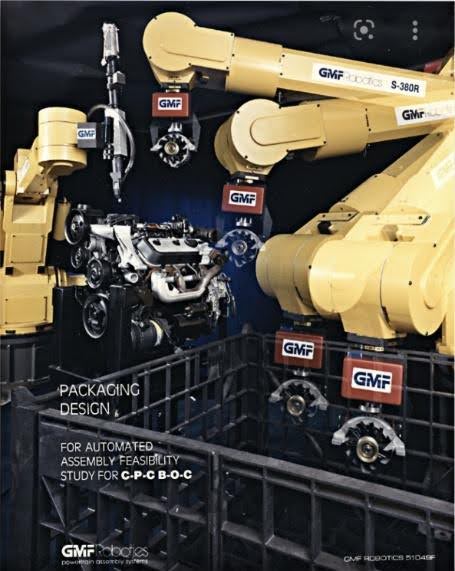
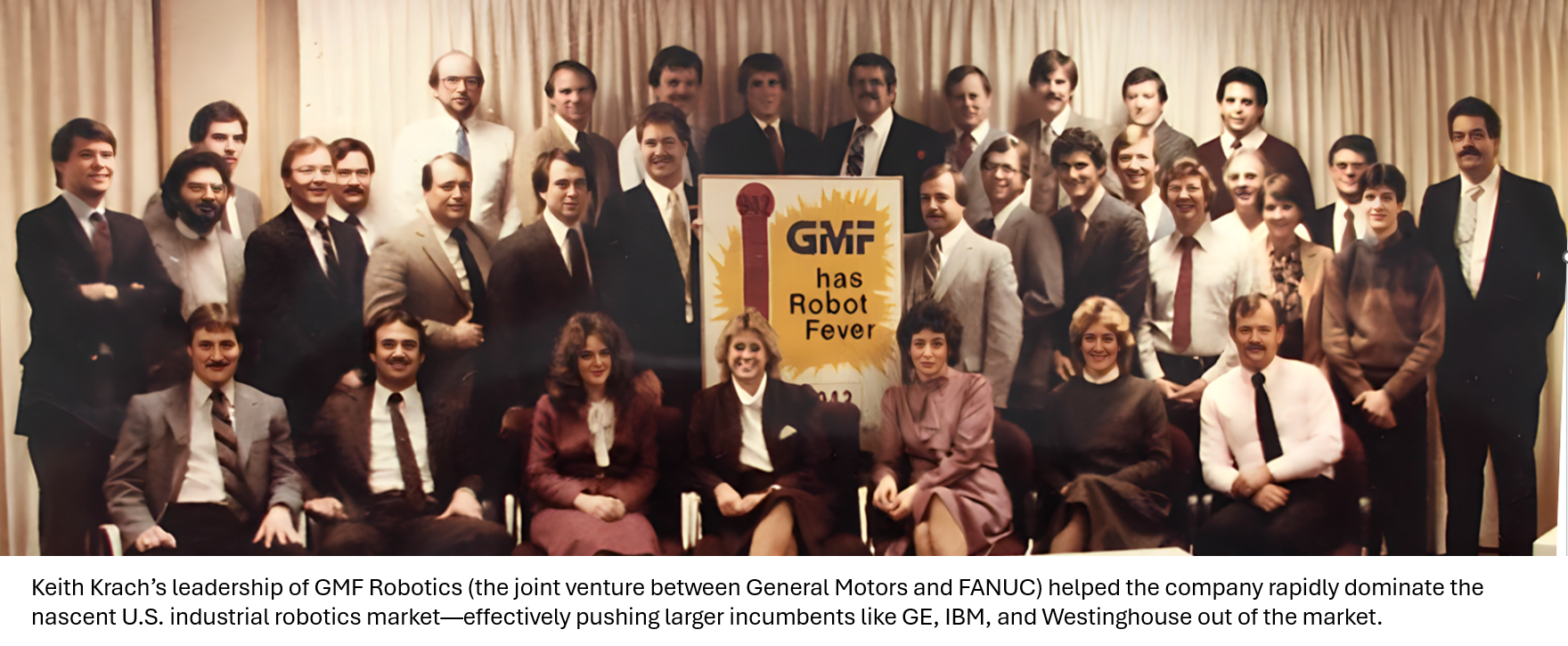
Krach understood that robotics were just the starting point. His real breakthrough was in systems thinking. With GMF as the nucleus, a broader ecosystem emerged—spanning vision systems, advanced sensors, materials science, and predictive analytics. Suppliers, engineers, and manufacturers coalesced into a global network, driven by Krach’s belief that productivity isn’t just about technology—it’s about trust, collaboration, and architecture.
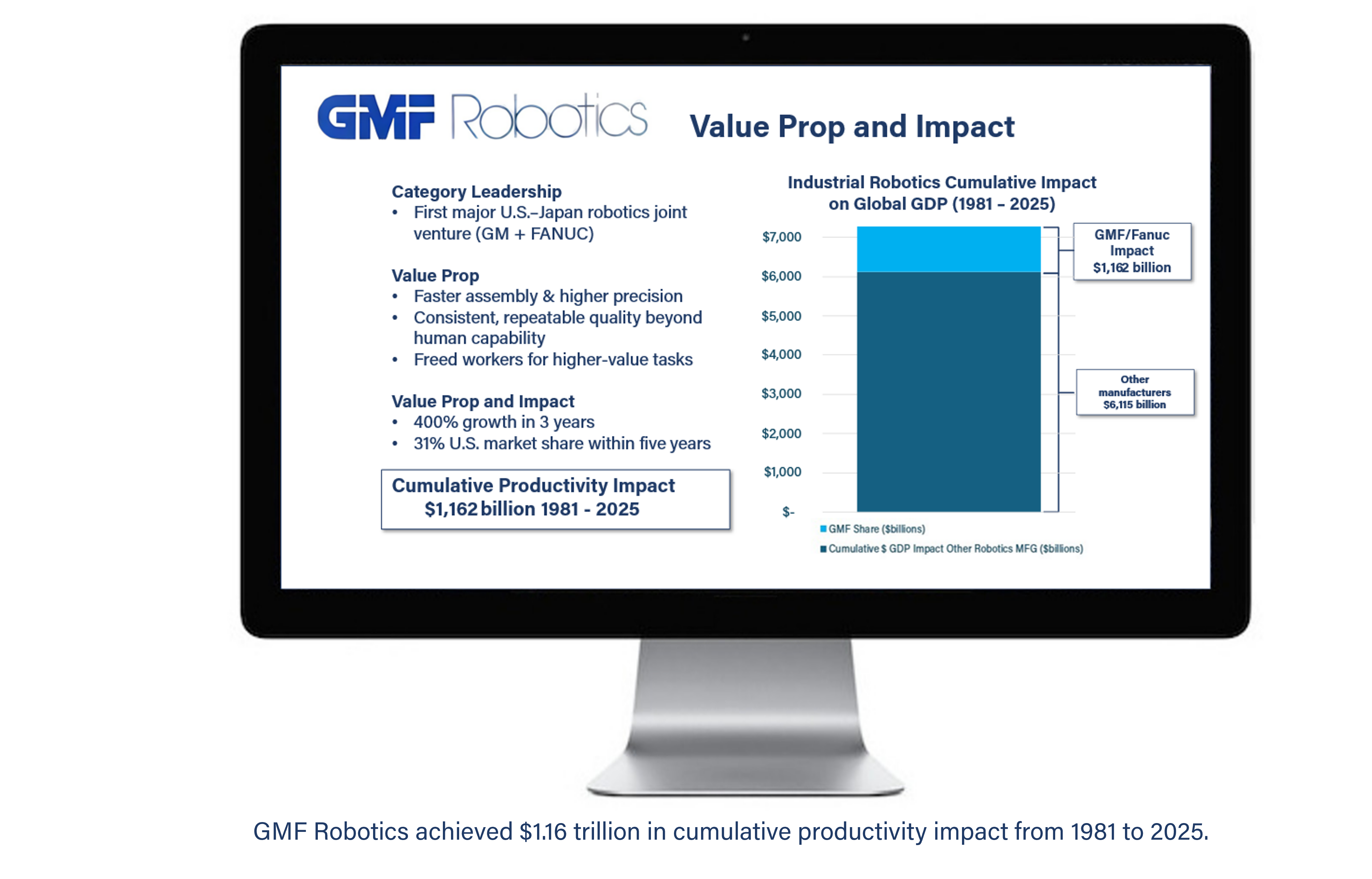
Under Krach’s leadership, GMF Robotics helped pioneer flexible automation across global supply chains. Its innovations shaped the industrial playbook still used today, and its ripple effects are enormous: an estimated $7 trillion in productivity gains from 1980 to 2025. Krach’s direct leadership is credited with driving $1.16 trillion in global GDP growth through early deployments, training programs, and system-wide standards. Today, as nations seek to reshore manufacturing, rebuild supply chains, and defend against disruption, GMF’s blueprint is more relevant than ever.
“Keith’s career is a story of one giant leap after another focused on creating value and improving the ways in which we all live and work.”
— Mitch Daniels, Former Governor, of Indiana, 12th President, Purdue University
Engineering Automation: The Rasna Revolution
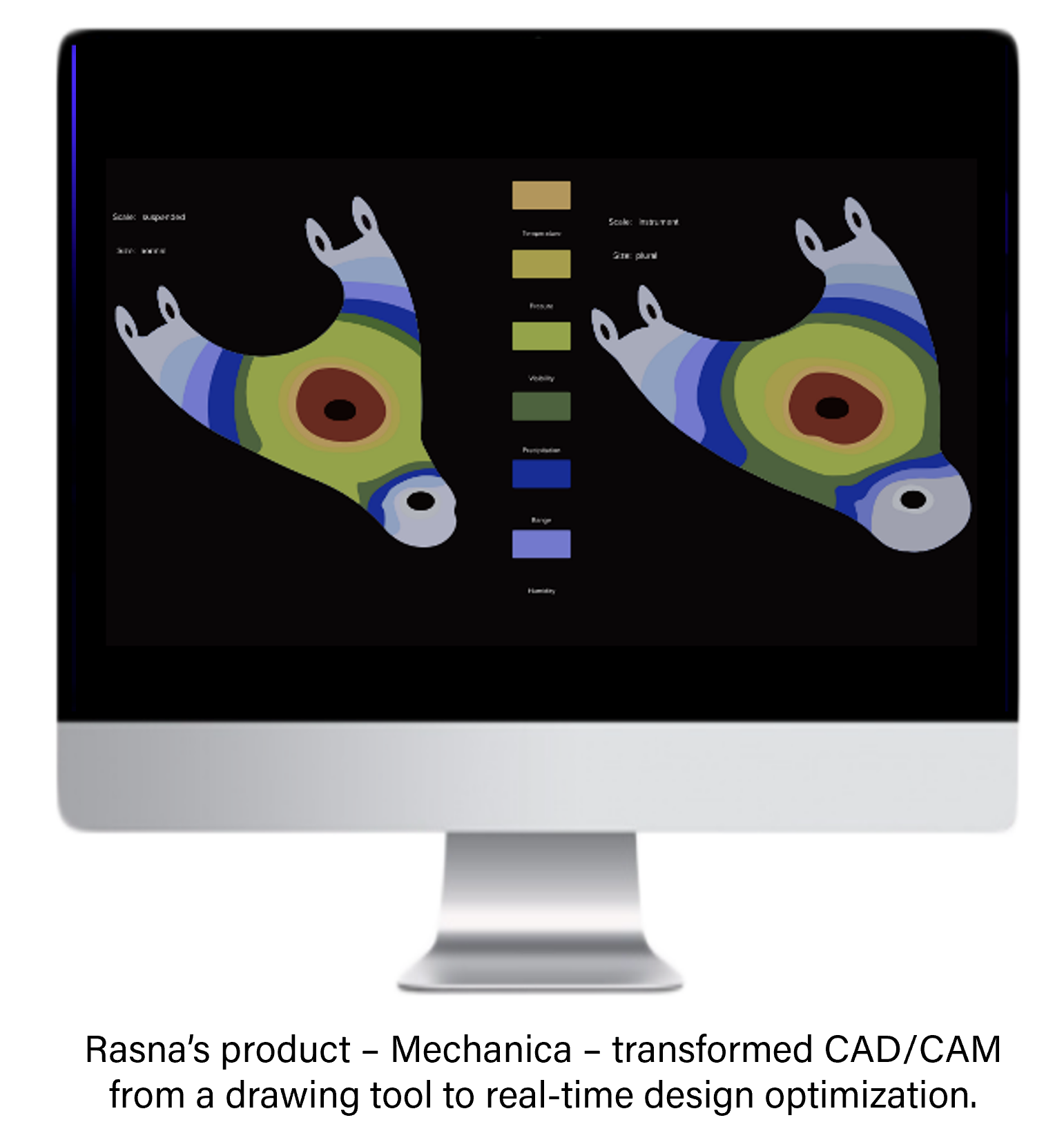
In 1988, after leaving GM, Krach co-founded Rasna Corporation with a bold idea: what if engineers could not only create designs, but analyze and optimize them in real time?
The result was Mechanical Design Synthesis (MDS)—software that combined physics, constraints, and geometry into an intelligent engineering process.
At the time, existing computer-aided design (CAD) software was not much more than a sophisticated drawing tool. It made it possible for designers to create images but offered no way for engineers to test their designs.
Design testing was done by analysts using complicated mathematics known as finite element analysis (FEA) which often required a Ph.D. This time-consuming process was iterated until designs were finalized. In the end, engineers and designers could know that their designs were adequate, but there was no way of knowing whether the final design was the optimal one.
| “We reduced our technical risk factor by a third using MECHANICA.” — Dave Rodriguez, Western Design “Mechanica cut our product development time by 40%.“ — Mike Mueller, ALCOA “This model took 1.5 days. Physical prototyping would’ve taken 10 weeks.“ — B Wood, Tektronix |
Rasna revolutionized the computer-aided engineering (CAE) industry by shifting optimization and finite element analysis from PhD-level analysts to everyday design engineers, enabling them to perform “what-if” and optimization analyses themselves directly within their design workflow—something not possible before.
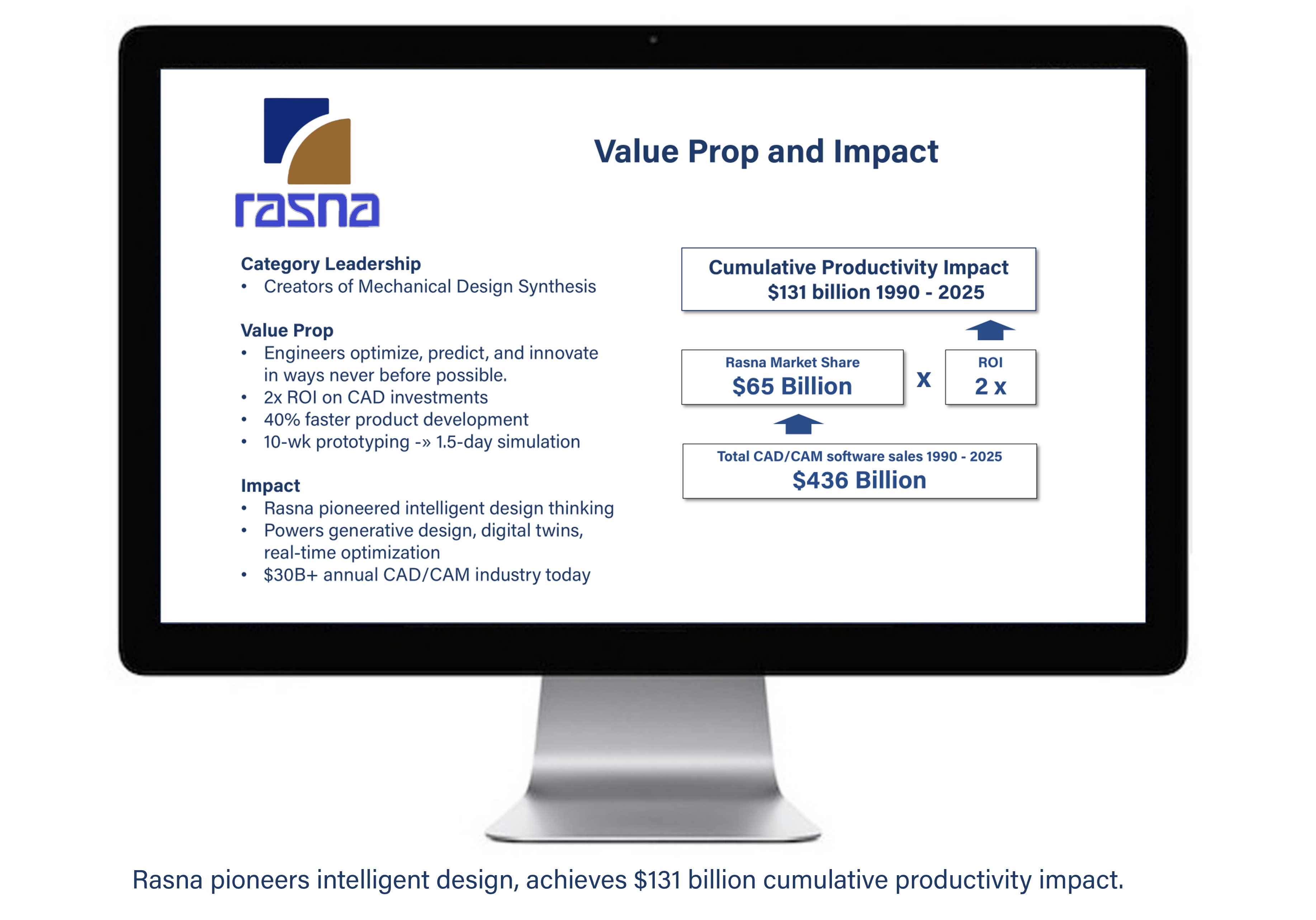
Analysts estimate Rasna enabled over $131 billion in productivity gains by accelerating development, cutting prototyping costs, and improving design reliability. Today, CAD/CAM is a $30+ billion annual industry, powering design-driven manufacturing worldwide.
By 1994, Rasna’s success was so profound that Inc. Magazine named it the 3rd fastest-growing private company in the U.S. Its pioneering approach laid the foundation for modern generative design, digital twins, and real-time optimization.
Krach wasn’t just building a product. He was shifting a paradigm.
Ariba and the Birth of Digital Commerce
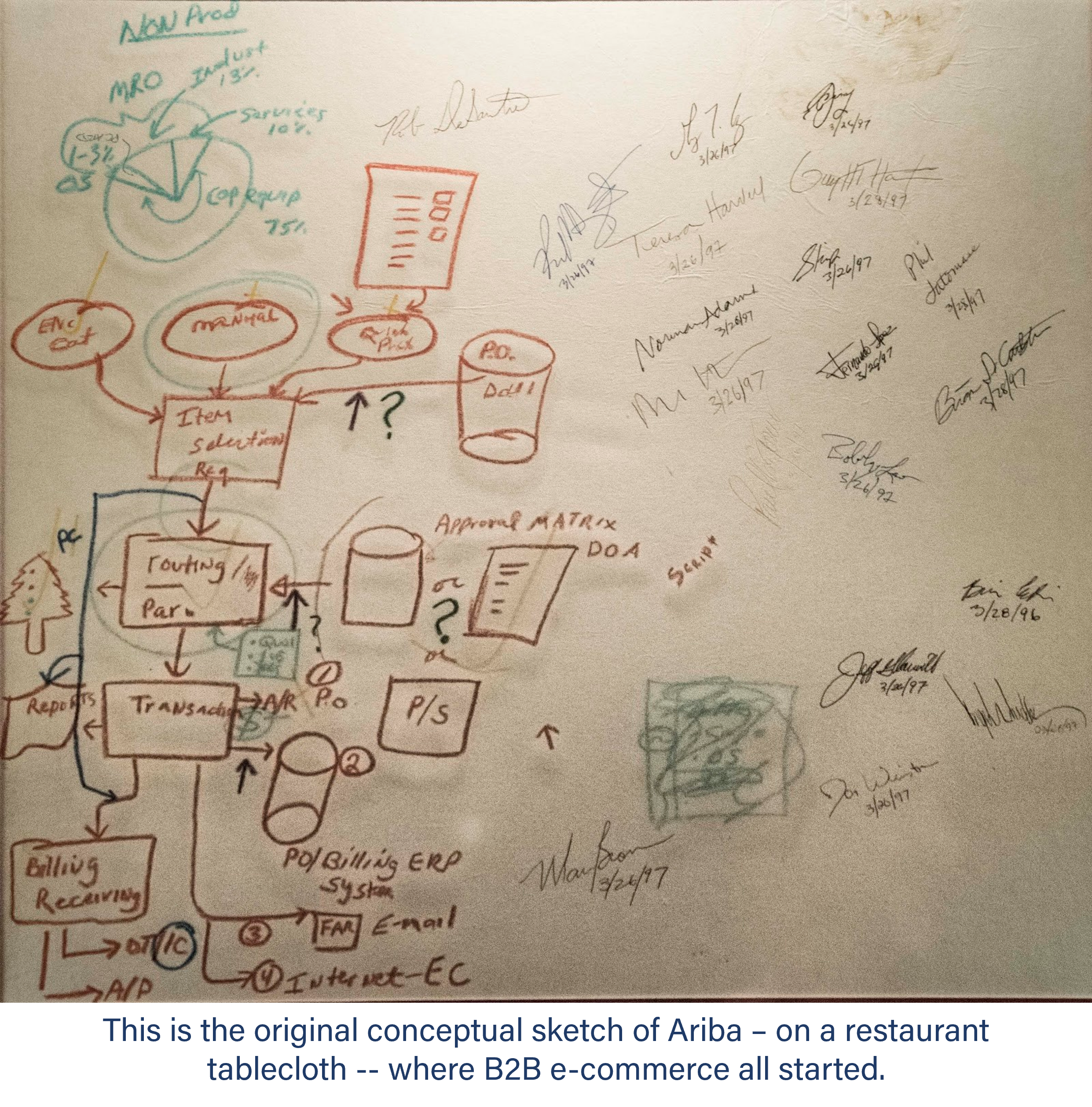
In 1996, Keith Krach co-founded Ariba with a bold vision: transform procurement from a slow, manual back-office function into a real-time, digital marketplace. At the time, business-to-business transactions were painfully inefficient — driven by phone calls, spreadsheets, and faxes. Procurement teams operated in silos with little visibility, often waiting weeks for supplier responses. Trust, speed, and transparency were nonexistent.
Krach and his team saw an opportunity to create a digital marketplace that would connect businesses everywhere on a common, intelligent platform. More than just automation, Ariba introduced transparency, trust, and speed into the world’s oldest industry — commerce.
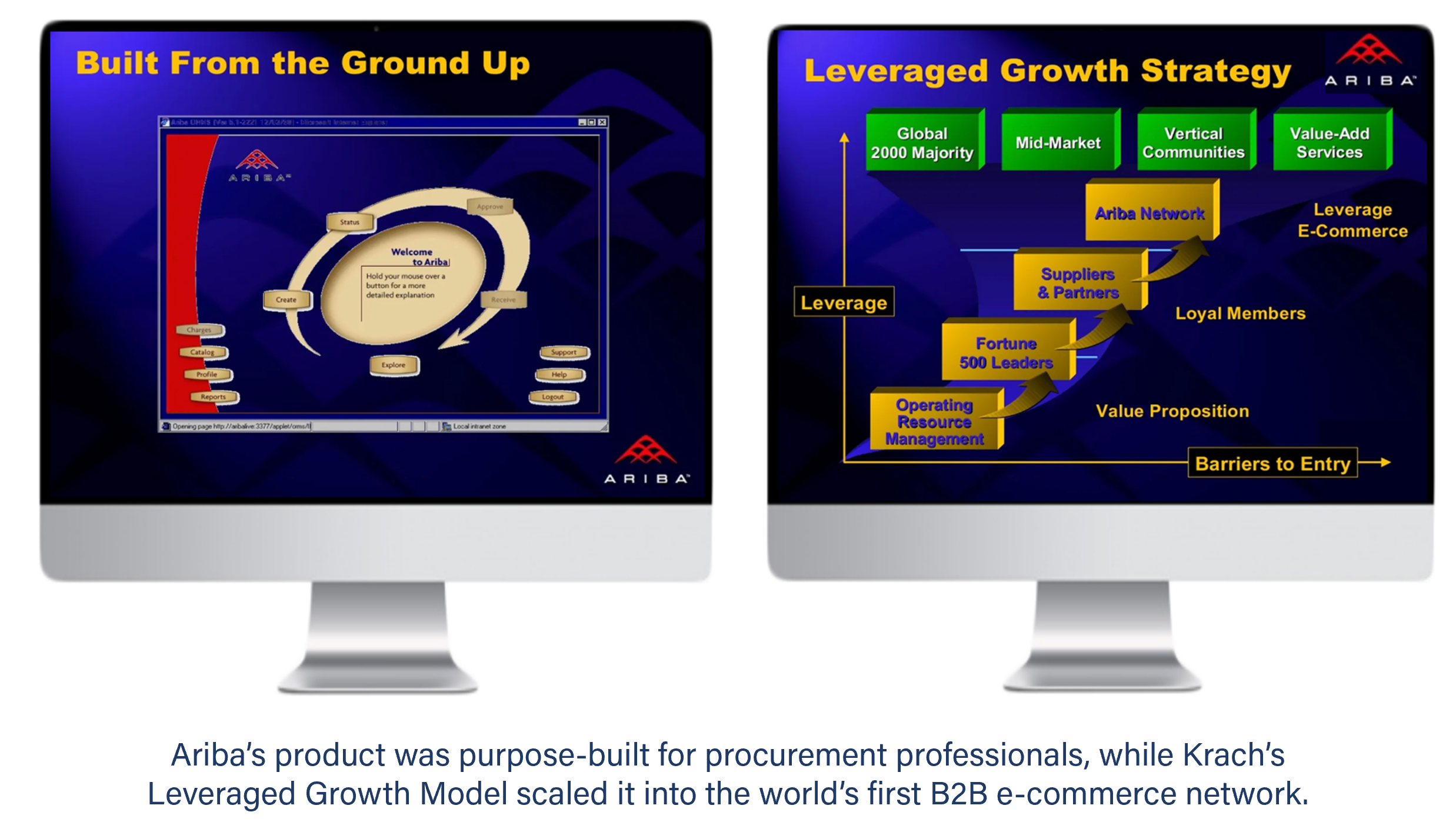
Ariba revolutionized the B2B world by creating the e-commerce category itself — transforming procurement from a fragmented, manual process into a fully digital, cloud-based, real-time global marketplace. Krach’s vision proved that trust and transparency could scale even in the complex world of inter-company commerce.
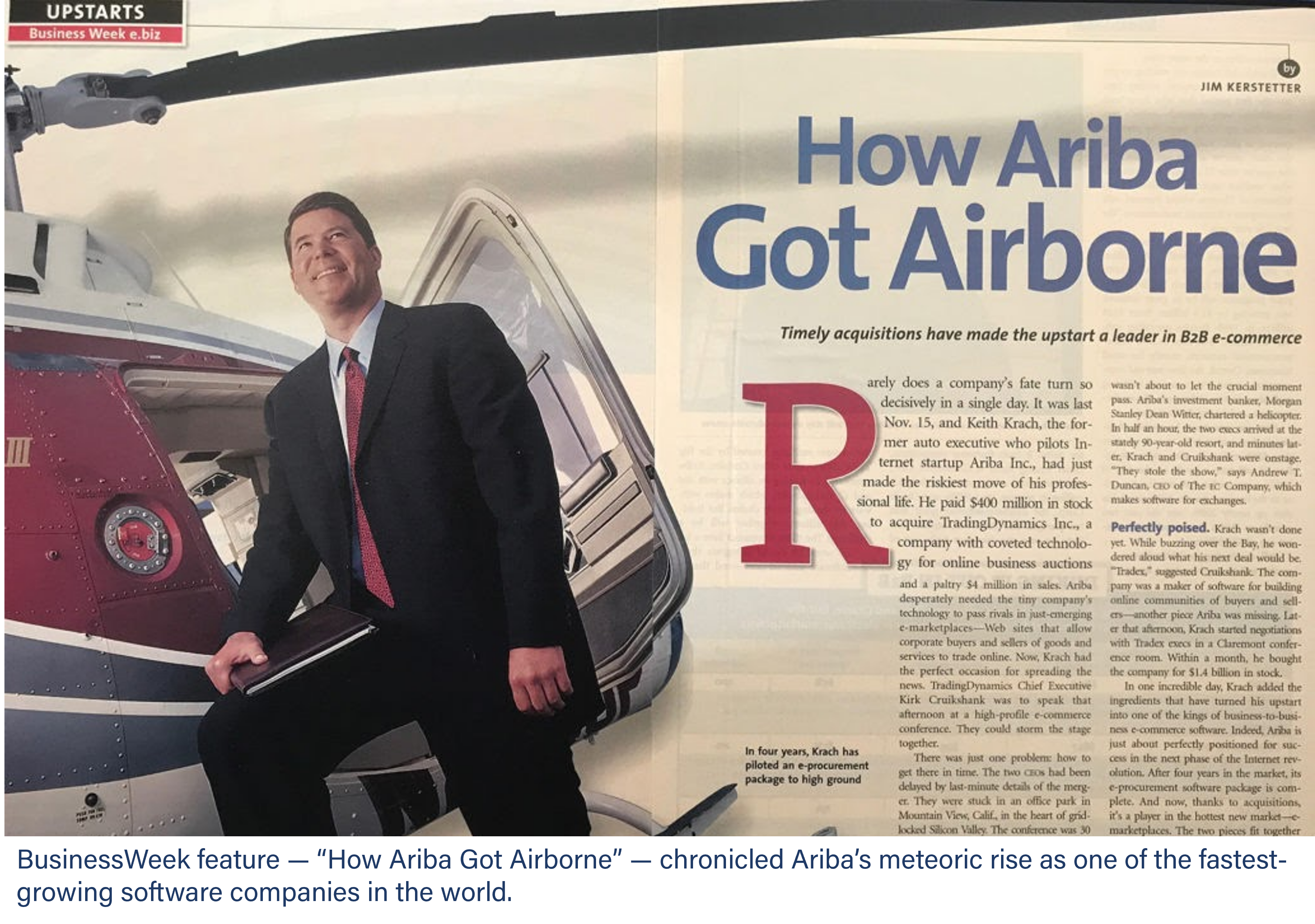
By the early 2000s, Ariba had become one of the most valuable enterprise software companies in the world, with a peak market cap of $40 billion. SAP later acquired Ariba, embedding its platform into global enterprise systems.
“Ariba is one of those companies that comes along and creates a sea change in the way businesses and individuals organize themselves or conduct business. Keith Krach … is the guy rowing the boat.”
— Forbes
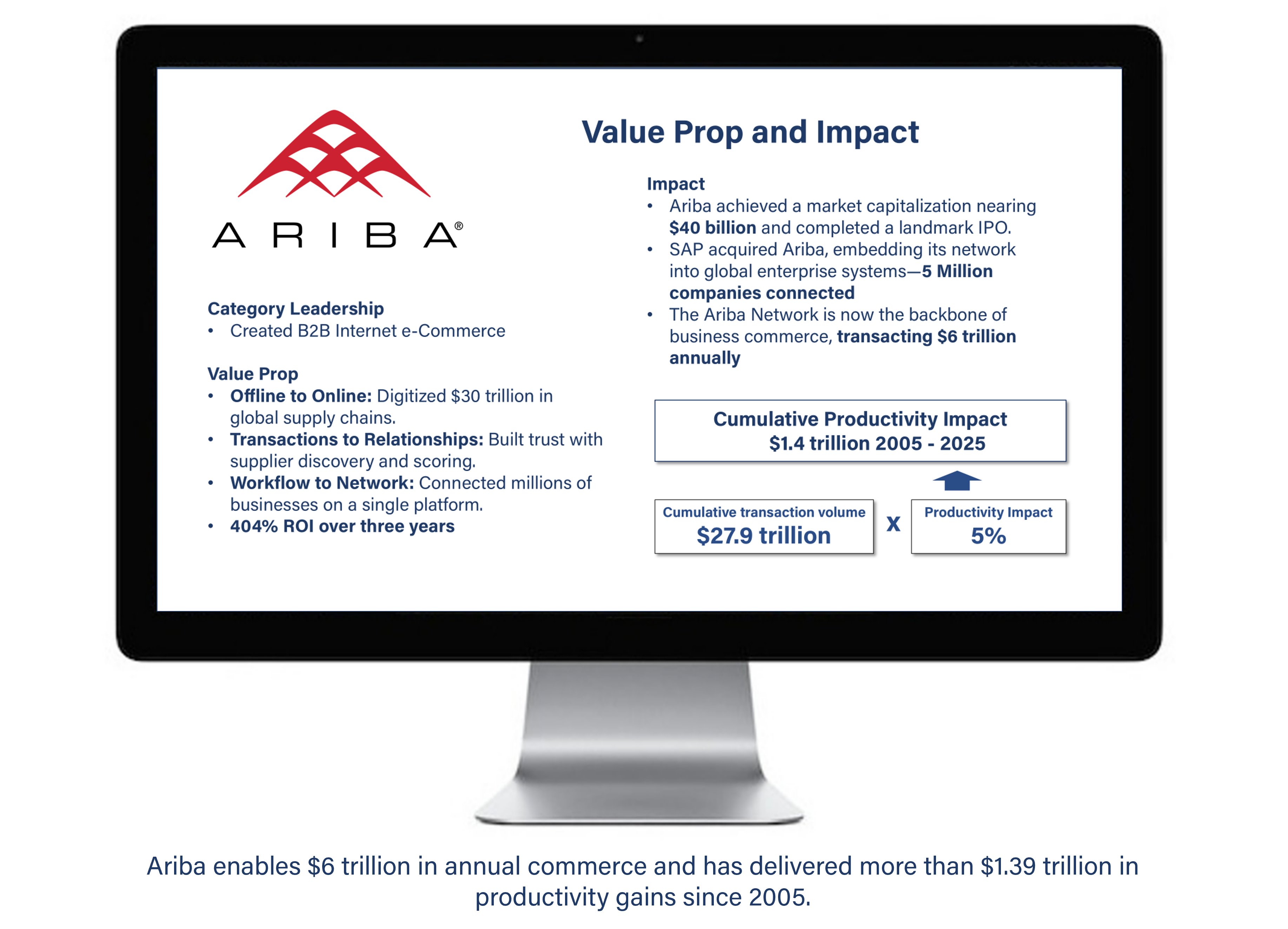
The Ripple Effect
- Digitized $30 trillion in global supply chains
- Built a network now connecting 5 million companies worldwide
- Reduced procurement costs by up to 20%
- Cut transaction times from weeks to hours
- Delivered $1.39 trillion in cumulative productivity gains
The ripple effects were systemic: thousands of procurement professionals retrained for digital platforms, hundreds of complementary software companies launched, and enterprise purchasing strategies were redefined around real-time analytics and automation.
Krach’s influence was about more than transactions and productivity. Most of the Ariba team remember him best for his impact on the people he brought together and empowered.
Today, the Ariba Network is the backbone of B2B commerce — a digital marketplace where trillions in transactions flow each year, proving that Krach’s original vision of trust and transparency at scale reshaped the global economy.
DocuSign: Trust at the Speed of Light
If Ariba eliminated friction from B2B commerce, DocuSign eliminated it from trust itself—and in doing so, it became the foundation for confidence in the digital economy. In 2009, Krach joined DocuSign as Chairman and became CEO in 2011, with a vision that agreements could be reimagined for the digital era. He understood that agreements — between people, companies, or governments.
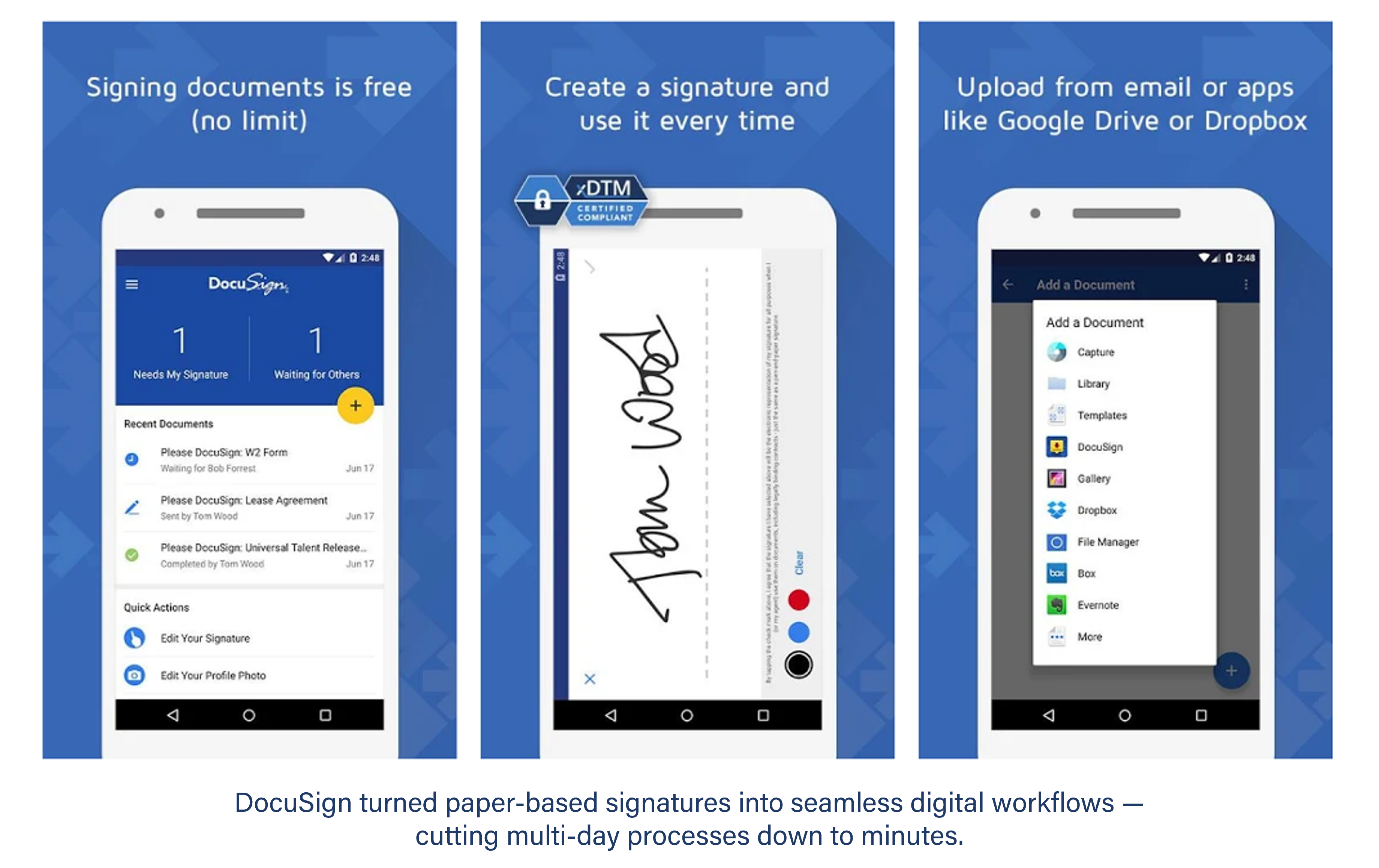
Krach reimagined DocuSign from a simple signing tool into a System of Agreement — a full lifecycle platform for how agreements are created, executed, managed, and enforced. Under his leadership, DocuSign integrated identity verification, legal compliance, and workflow automation so agreements could flow seamlessly across organizations.
He also launched the DocuSign Trust Network, integrating identity verification, cybersecurity, and regulatory compliance into one secure architecture — laying the foundation for scalable, enterprise-grade digital trust. As DocuSign’s user base grew to more than 1.7 million companies and over 1 billion users in 180 countries, its impact multiplied.
Krach’s vision turned DocuSign into the gold standard for digital transaction management and a cornerstone of the Zero Trust cybersecurity movement. Analysts now cite platforms like DocuSign as key drivers of enterprise digital transformation, operational resilience, and even GDP growth.
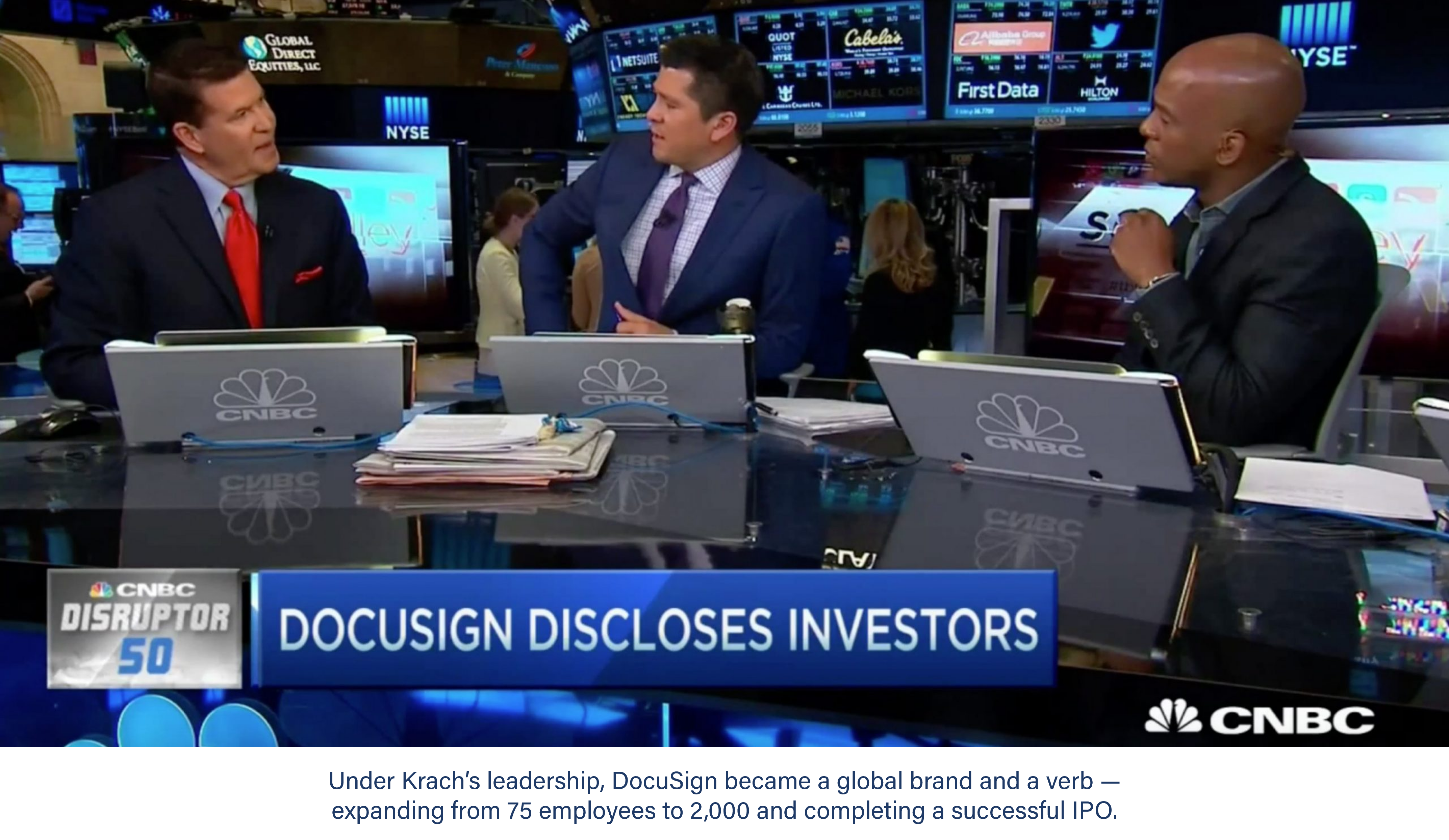
Strategic Chess Moves that Made DocuSign the Global Standard
- Category Creation: Krach positioned DocuSign as the pioneer of Digital Transaction Management (DTM), later expanding to System of Agreement (SOA) — making DocuSign synonymous with trust itself.
- Beachhead Strategy: Starting with real estate, then expanding beachhead by beachhead — industry verticals, geographies, and use cases — DocuSign methodically scaled its network.
- Strategic Equity Partnerships: DocuSign raised smart capital while forging deep partnerships with Microsoft, Google, SAP, Visa, Salesforce, and Samsung. These deals combined equity, customer agreements, integrations, and go-to-market strategies — turning potential competitors into allies.
- Standards Leadership: Krach drove the creation of the xDTM Standard for digital transactions — comparable to PCI in payments — institutionalizing DocuSign’s framework for trust across security, privacy, compliance, and enforceability.
- Advisory Board Scale: By recruiting 200+ global executives to its Advisory Board, DocuSign gained market intelligence, executive reach, and customer adoption — “people support what they help create.”
- Branding: Krach transformed the company name into a verb, like Google or Xerox – as in: “Can you DocuSign that form?”
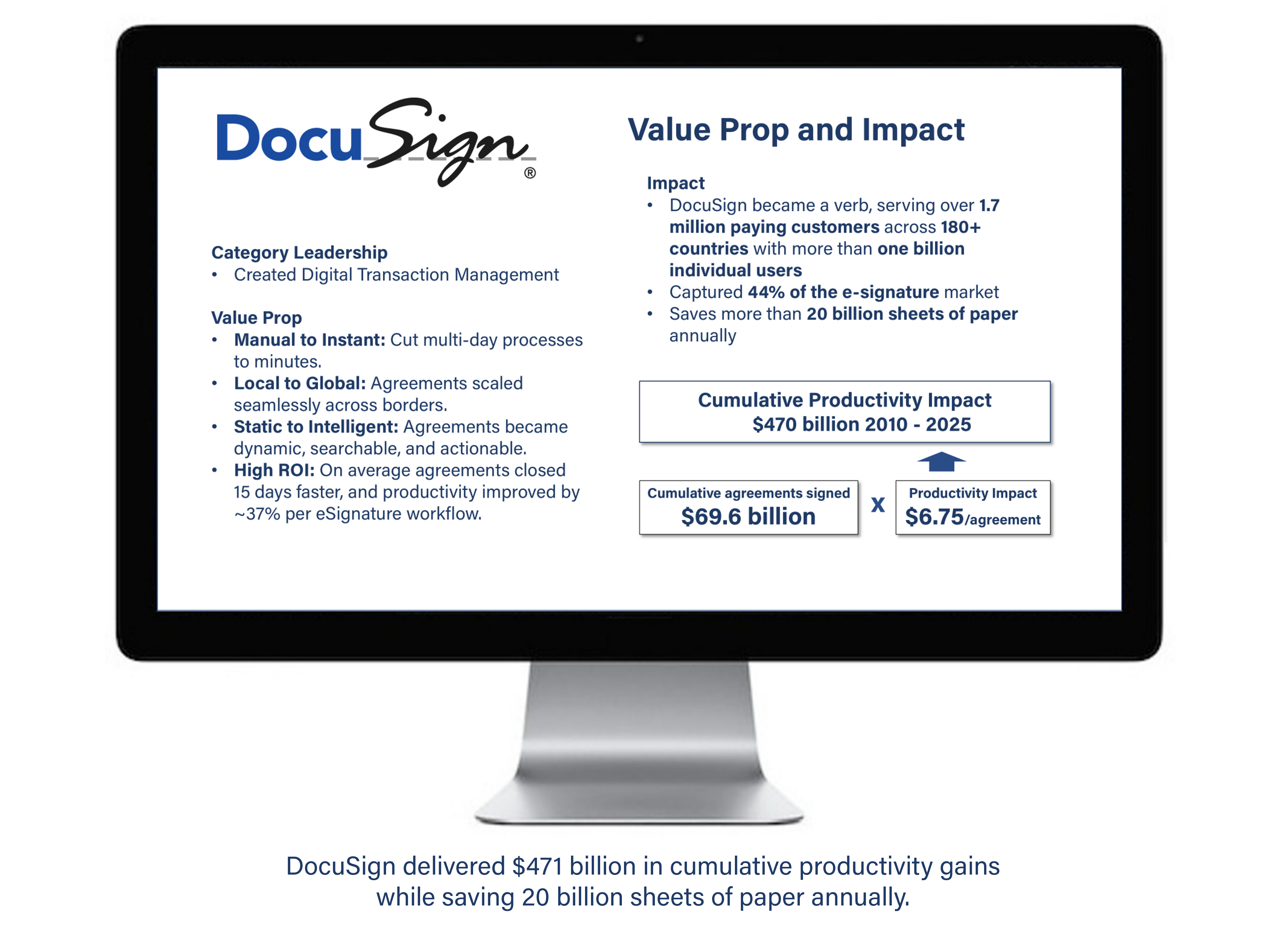
The Ripple Effect
- Saved 20 billion sheets of paper annually
- Delivered $10 in productivity gains per transaction (Forrester)
- Generated more than $471 billion in cumulative productivity gains (2010–2025)
- Became a cornerstone of the Zero Trust cybersecurity movement
- Cited as a driver of enterprise digital transformation, resilience, and GDP growth
By embedding trust at the core of agreements, Krach didn’t just build a product — he redefined what it means to agree.
“Throughout his career, Keith has brought powerful transformational leadership to many sectors — factory automation, engineering, commerce, education, philanthropy, leadership development, and even the way people sign,” said Salman Khan, Founder and CEO of Khan Academy. “His focus on innovation and productivity… has resulted in a profound impact on GDP per capita, international trade, and the sustainability of our planet.”
Semiconductors: Reshoring Sovereignty
After decades of private sector leadership, Keith Krach brought his playbook to government. As U.S. Under Secretary of State, his mission was clear: to develop and operationalize a global economic security strategy that would drive economic growth, maximize national security, and counter authoritarian aggression.
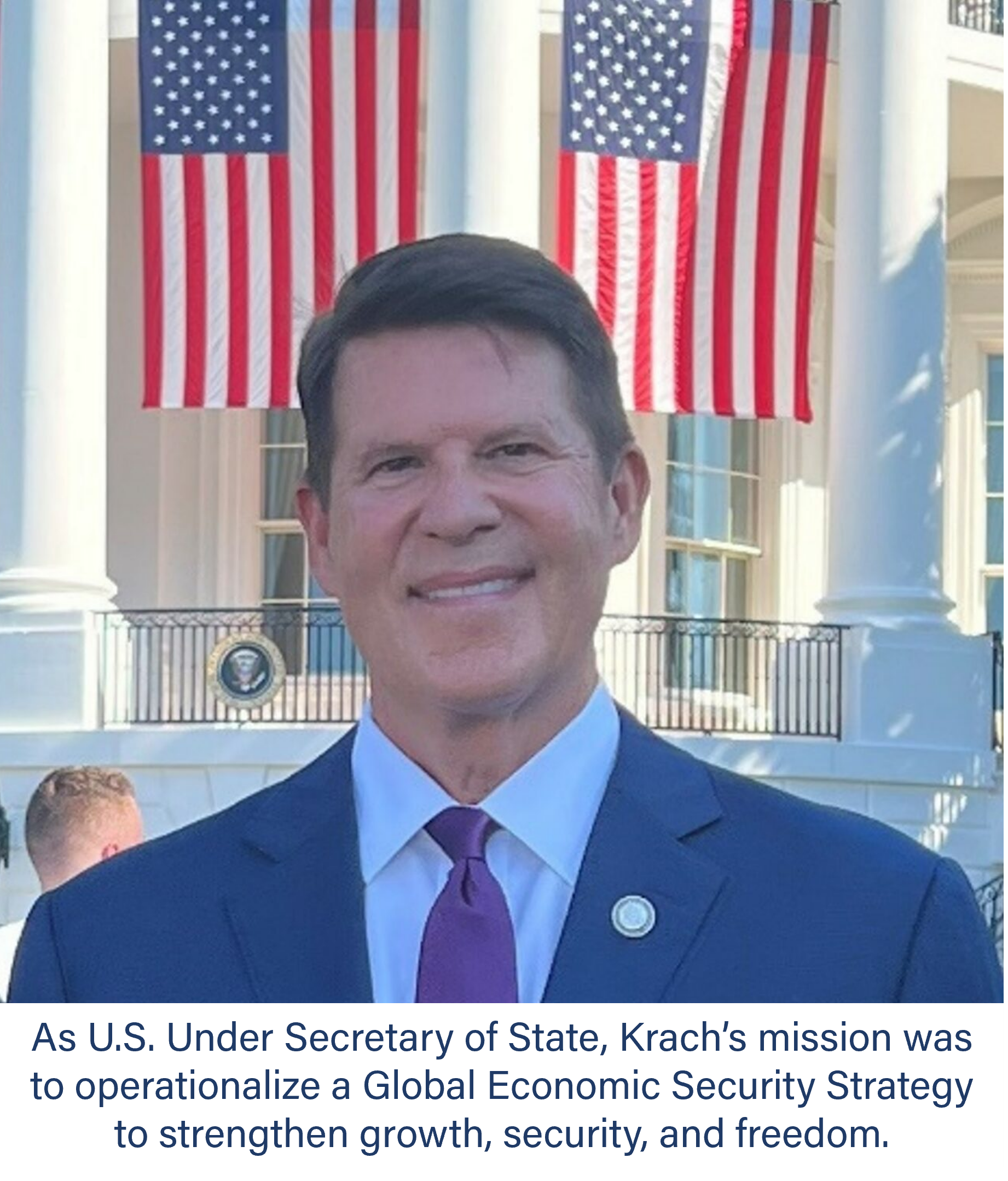
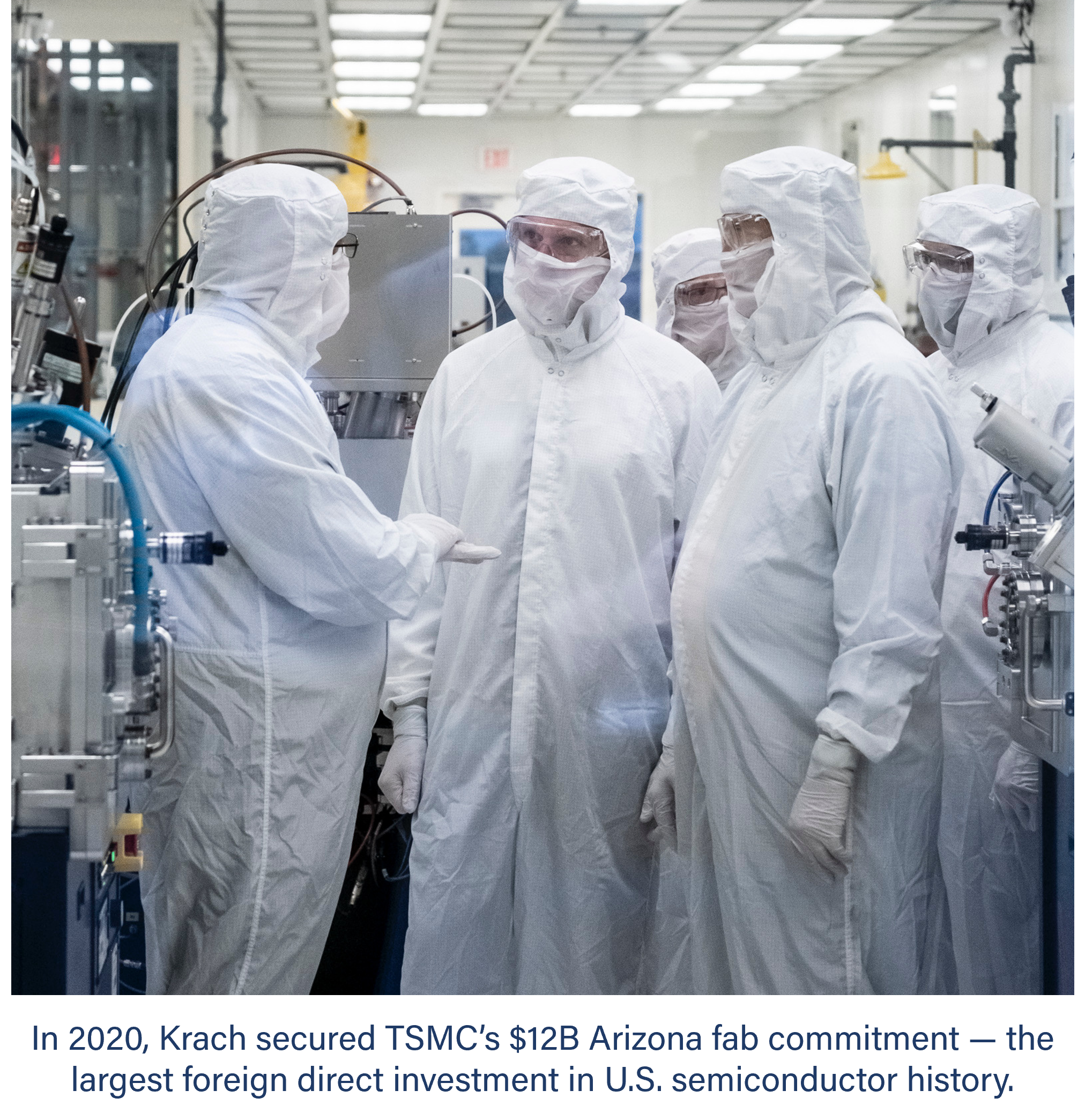
Few areas made the stakes clearer than semiconductors. By 2020, the United States had fallen to just 12% of global chip manufacturing, down from 37% in 1990. The COVID-19 pandemic and rising Chinese aggression exposed how dangerous this decline had become. Supply chains buckled, military readiness was questioned, and entire industries faced existential risk.
Krach quickly realized that not a single semiconductor company was planning to build advanced manufacturing capacity in the United States. He spoke with them all — Intel, Samsung, Micron — and the answer was always the same: too costly, too risky, too far from the ecosystem.
That’s when Krach zeroed in on the global leader: Taiwan Semiconductor Manufacturing Company (TSMC). If he could convince the world’s most advanced chipmaker to place its most critical technology on U.S. soil, he knew it could spark a domino effect.
In May 2020, after only two weeks of high-stakes negotiations, TSMC announced it would build a $12 billion fab in Arizona — the largest foreign direct investment in U.S. semiconductor history at the time.
This bold and unconventional diplomatic initiative, rooted in trust and strategic leverage, broke the stalemate.As one senior TSMC executive put it: “Krach gave us the confidence to move forward in the U.S. He connected the dots between economics and national security.”
From that moment, America’s comeback had begun.
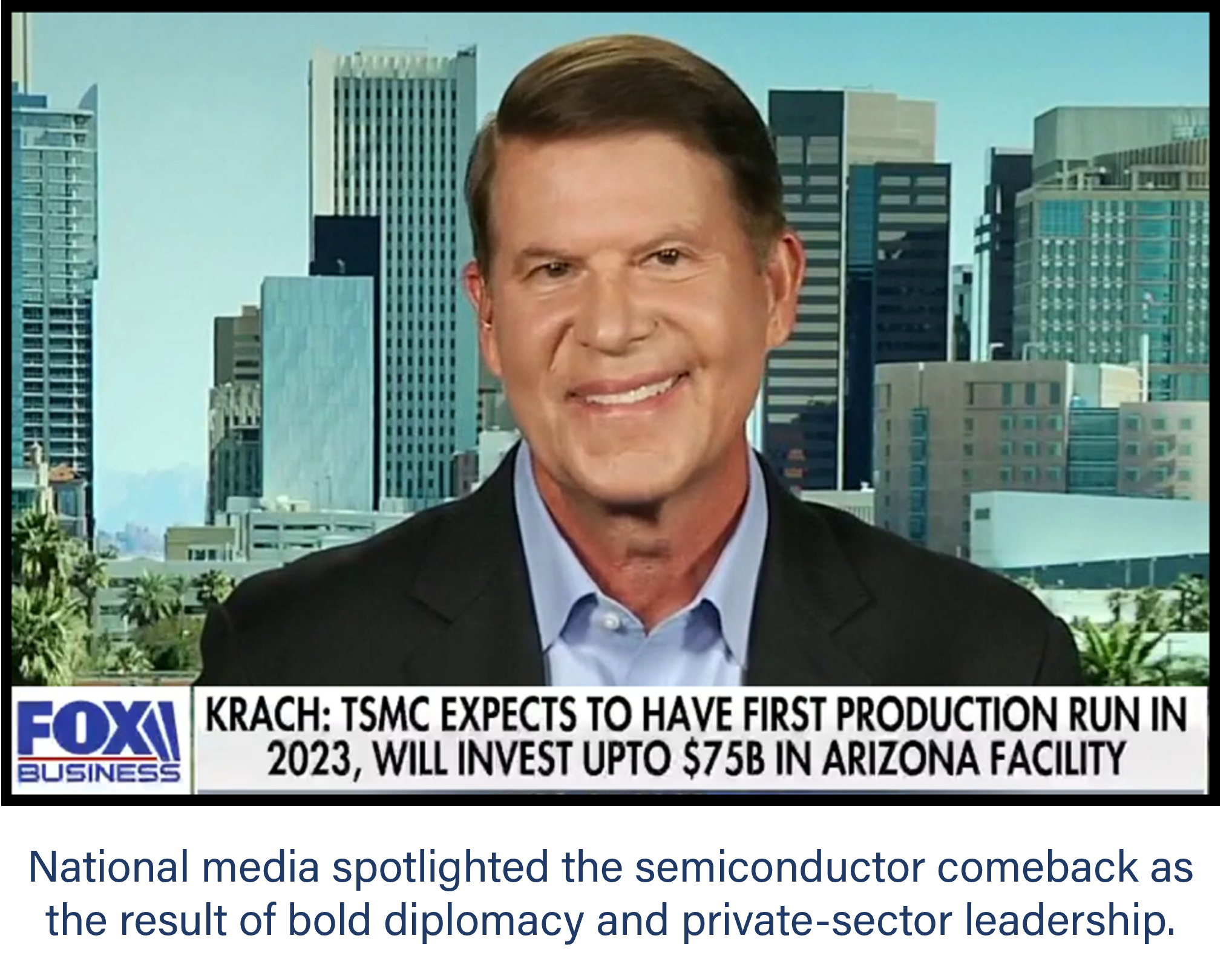
Krach’s landmark TSMC deal catalyzed private-sector confidence. Congress later codified this momentum with the CHIPS Act — but the real driver was diplomacy and market trust. It bridged government and industry, funded research and workforce development, and signaled to the world that American innovation and policy could work in tandem.
That breakthrough ignited an industrial revival. Intel committed $110 billion to new fabs in Arizona and Ohio. Samsung invested $44 billion in Texas. Micron pledged $20 billion in Idaho. More than 40 other companies and research institutions — SK Hynix, KLA, ASML, Amkor, and more — poured billions into the United States.

Once TSMC made its move, momentum snowballed. By 2022, the company expanded its Arizona commitment to $75 billion and three fabs. Phoenix became known as the “Silicon Desert” — ground zero for the largest industrial reshoring in modern American history. In 2025, in a joint announcement with President Trump, TSMC pledged another $100 billion — an unprecedented vote of confidence in America.
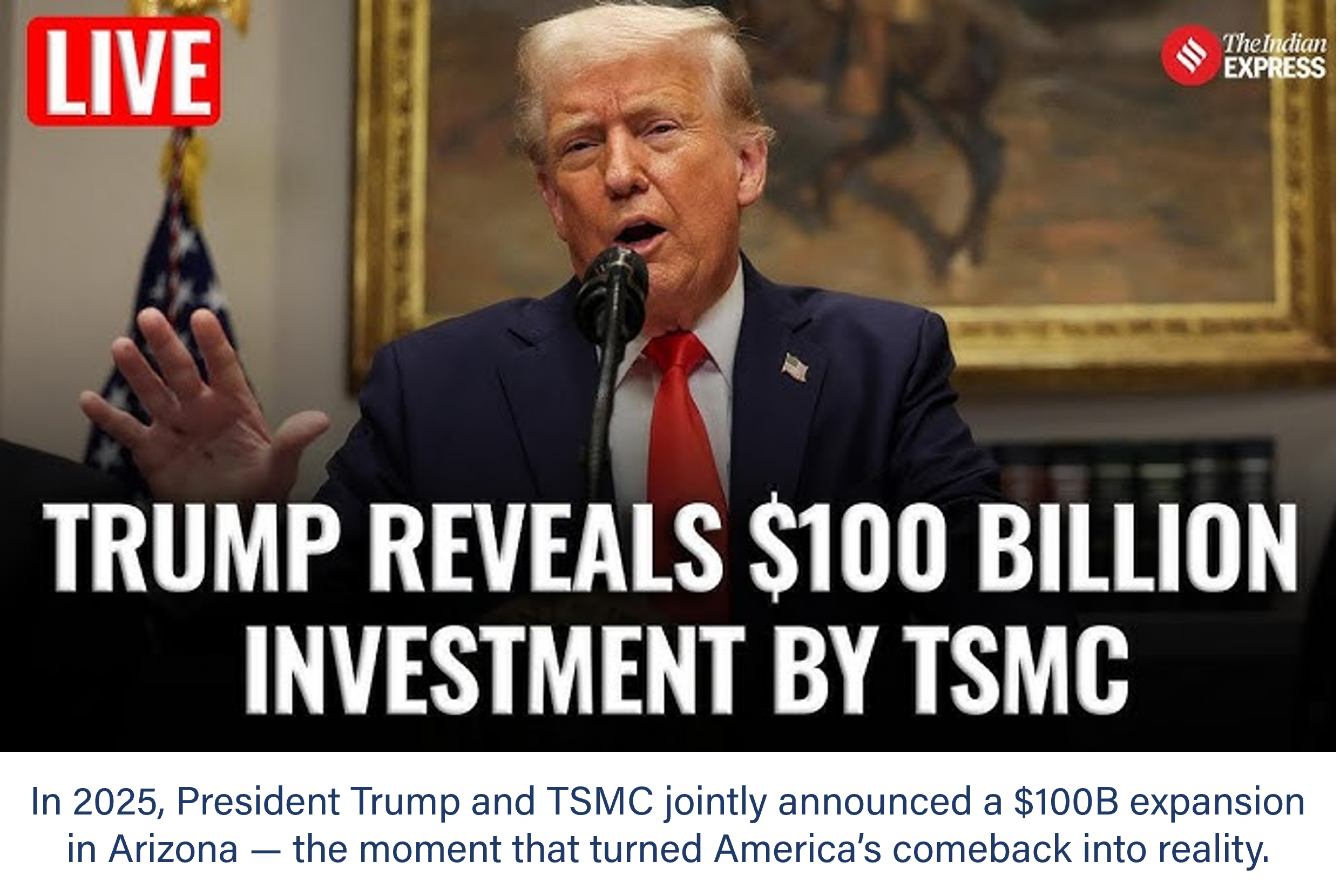
The scale was staggering: Economists estimate that the Krach’s combined semiconductor initiatives have already catalyzed nearly $600 billion in total semiconductor-related investment—mostly from the private sector.
Using conservative productivity multipliers, this industrial revival is projected to drive more than 125,000 jobs and $1.41 trillion in sustained GDP gains while reshaping the global manufacturing balance of power, marking a generational shift from decades of offshoring toward U.S. technological sovereignty.
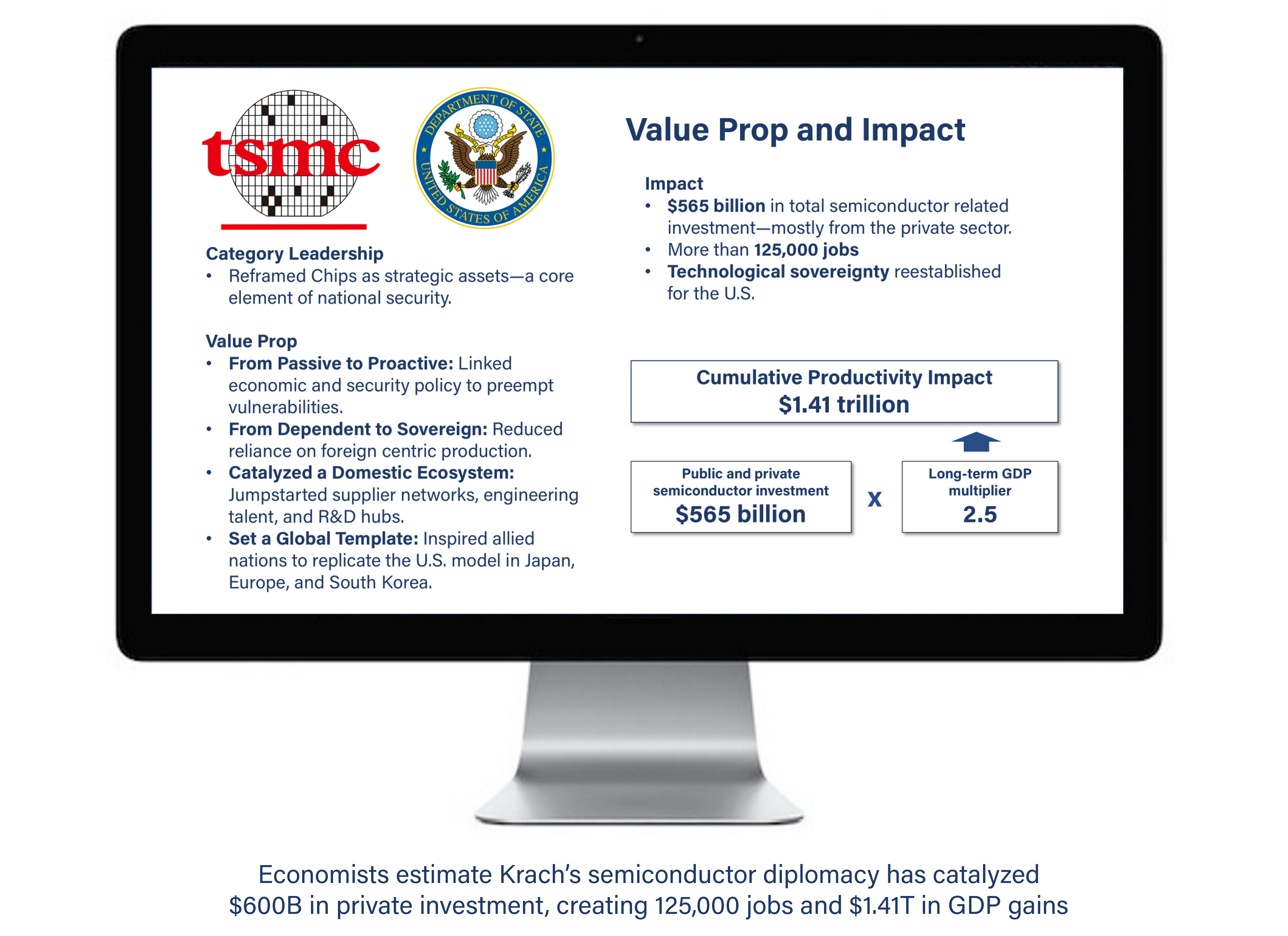
Krach’s landmark TSMC deal and push for congressional action, catalyzing over $500B in private semiconductor investment. These moves sparked the largest industrial reshoring in U.S. history. His semiconductor diplomacy proved that America’s comeback was not about subsidies — it was about confidence in America as the best place in the world to build.
With President Trump’s leadership amplifying the TSMC breakthrough, America is now undergoing the largest semiconductor expansion in its history — a generational shift from decades of offshoring to a new era of U.S. technological sovereignty.
Characteristically, Krach wasn’t just brokering a deal. He was securing the future.
A $4.5 Trillion Blueprint for American Prosperity and Global Leadership
Few leaders can quantify their life’s work in numbers. Rarer still is to tie it directly to measurable global economic uplift.
Yet, across five sectors and four decades, Keith Krach’s leadership has catalyzed more than $4.5 trillion in productivity gains, according to independent estimates drawn from global economic models and market data.
Independent analysis across five industries estimates Krach’s leadership has driven cumulative productivity gains of $4.57 trillion.
| Sector | Organization(s) | Estimated Impact |
| Robotics | GMF Robotics (GM/Fanuc JV) | $1,162 billion |
| Engineering Automation | Rasna Corporation (acq. by PTC) | 131 billion |
| B2B E-Commerce | Ariba (acq. by SAP) | 1,396 billion |
| Digital Business Productivity | DocuSign | 471 billion |
| Semiconductor Manufacturing | TSMC Arizona Project + CHIPS Act | 1,414 billion |
| Total | (Cumulative) | $4.57 Trillion+ |
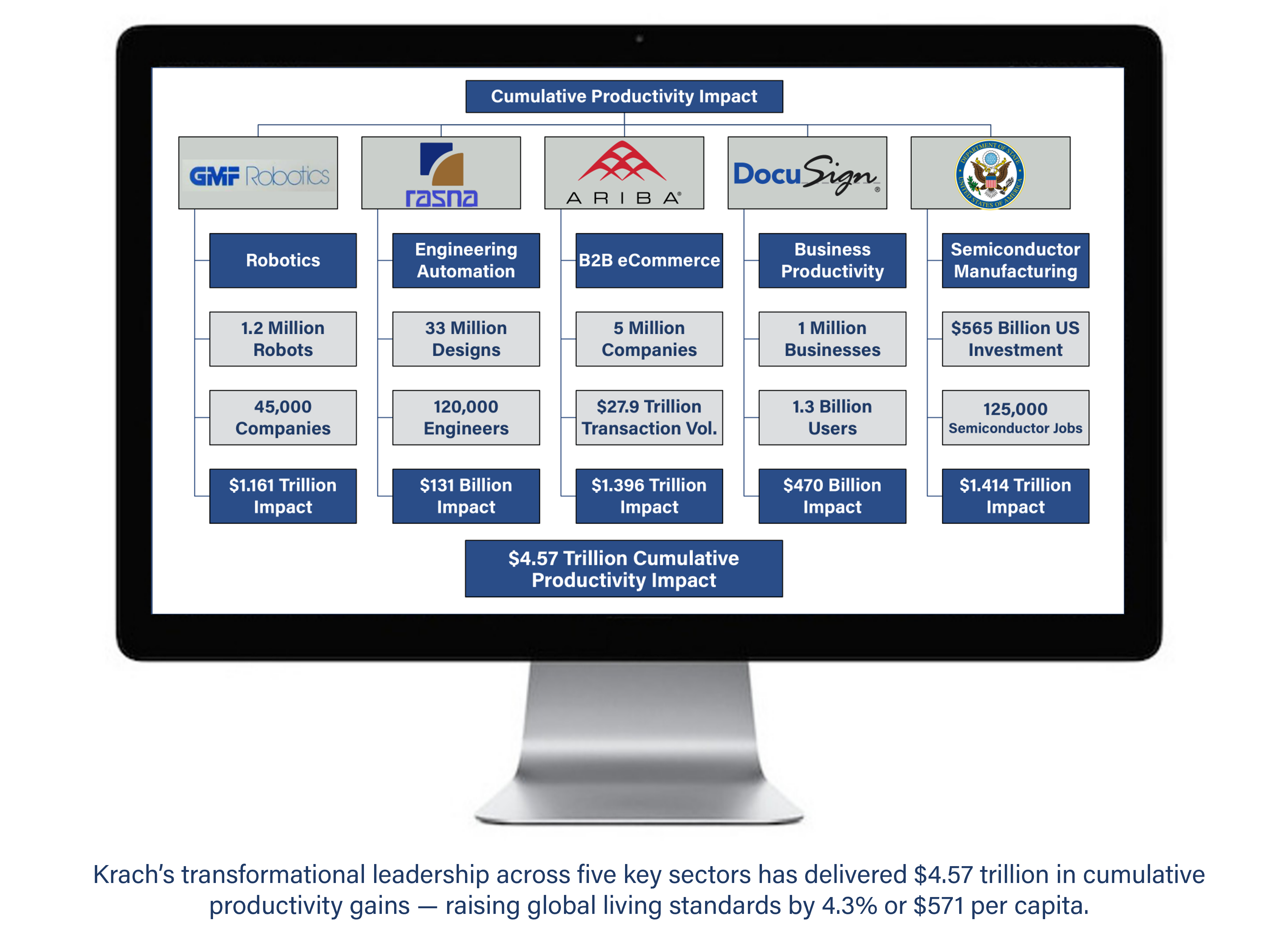
“When you look across sectors, the pattern is unmistakable,” says Joe Chung, founder and Chairman of the Secure Economic Ecosystem. “Krach didn’t just lead companies—he built platforms that reshaped economic behavior at scale.”
Krach’s accomplishments, vision, and mission inspired Life & News to launch a new Transformational Leader of the Year award, and name him its first recipient. The publication describes Krach as, “The kind of quintessential leader you encounter once in a lifetime, with an unmatched ability to transform his world, the people around him, and himself.”
Epilogue: The Architect of Trust
Keith Krach’s career has been defined by a rare combination of strategic vision and fearless action. As U.S. Under Secretary of State, he fortified alliances, safeguarded critical technologies, and built coalitions to defend freedom against authoritarian aggression. By uniting the public and private sectors around shared values of trust, transparency, and democratic principles, he redefined how economic strength and technological leadership can serve as pillars of national security.
“Keith Krach’s receipt of the nation’s highest manufacturing honor is more than a recognition of past achievements—it’s a signal of the kind of leadership America needs now,” said Mung Chiang, President of Purdue University. “At the intersection of technology and diplomacy, few have done more to advance U.S. productivity, resilience, and freedom.”
Krach himself frames it simply:

Today, that mission continues. As Chairman of the Krach Institute for Tech Diplomacy at Purdue, the Global Tech Security Commission, and the U.S.–Taiwan Business Council, Krach is training the next generation of leaders to ensure that technology advances freedom—not authoritarianism.
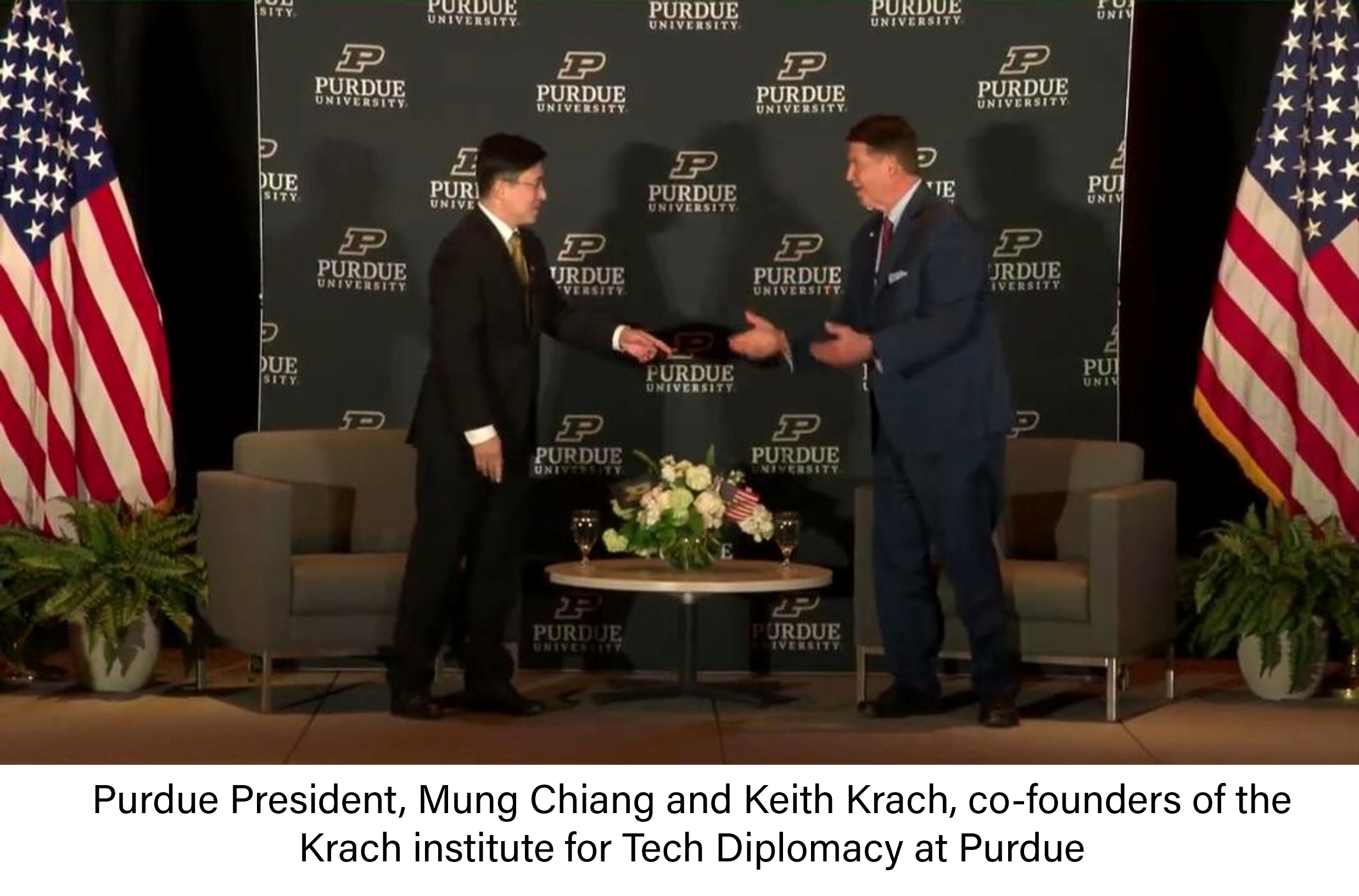
Founded in 2021 with Purdue President Mung Chiang, the Krach Institute has become the world’s leading voice for Tech Diplomacy, advancing imperatives that include:
- Educating global leaders in the practice of Tech Diplomacy
- Uniting nations, companies, and civil society in a Global Trusted Tech Network
- Crafting and executing strategies to counter authoritarian control of critical technologies
- Developing the Global Trusted Tech Standard to guide allies in safeguarding critical technologies from authoritarian influence.
Krach’s journey demonstrates a powerful truth: productivity is not just about efficiency—it is the architecture of prosperity, resilience, and national security.




